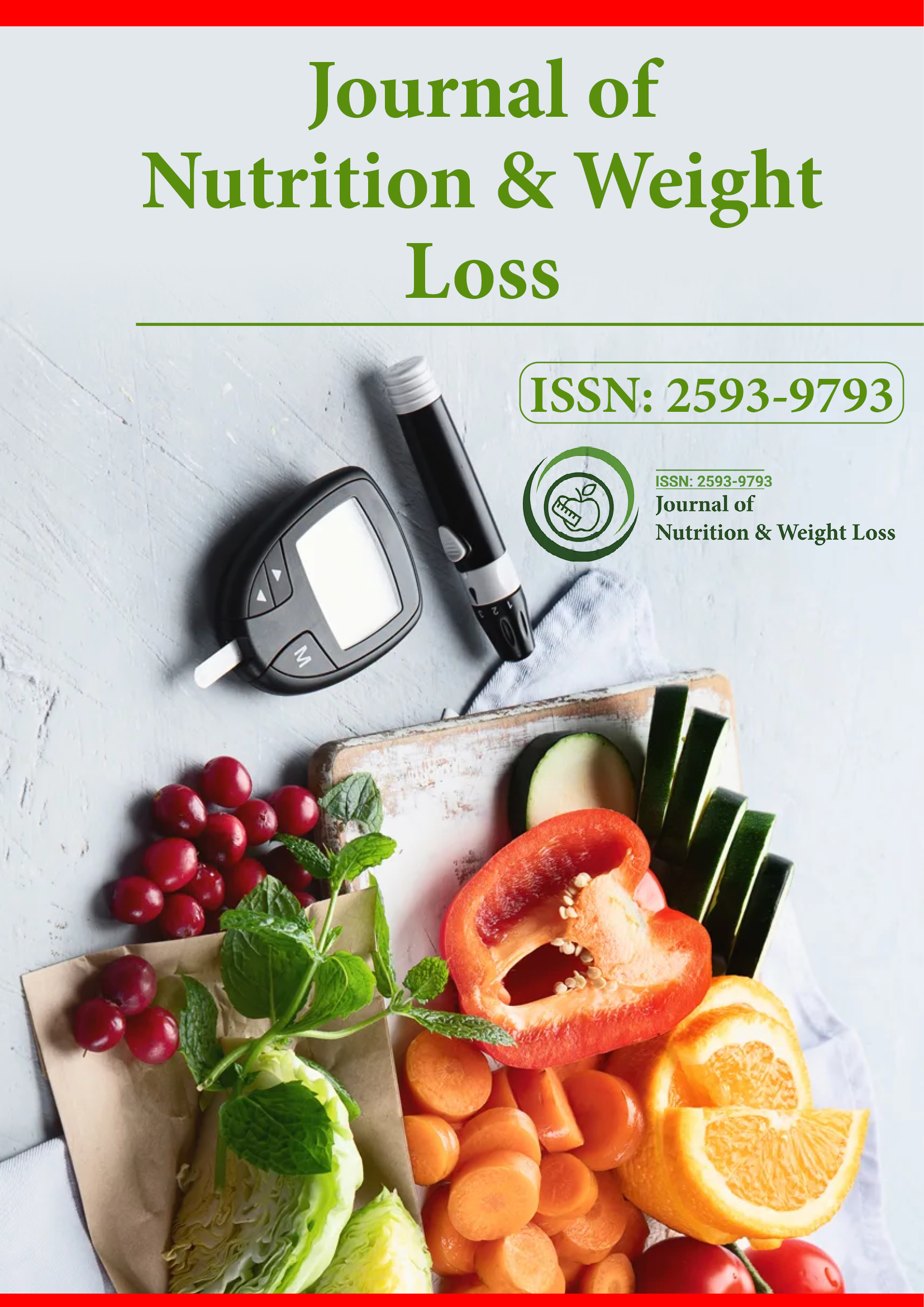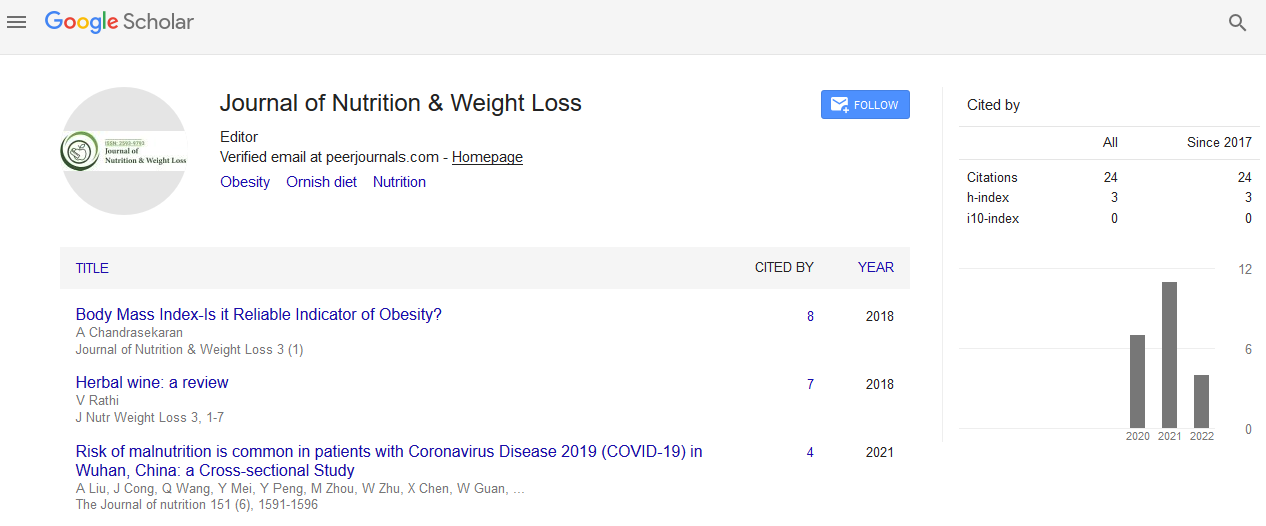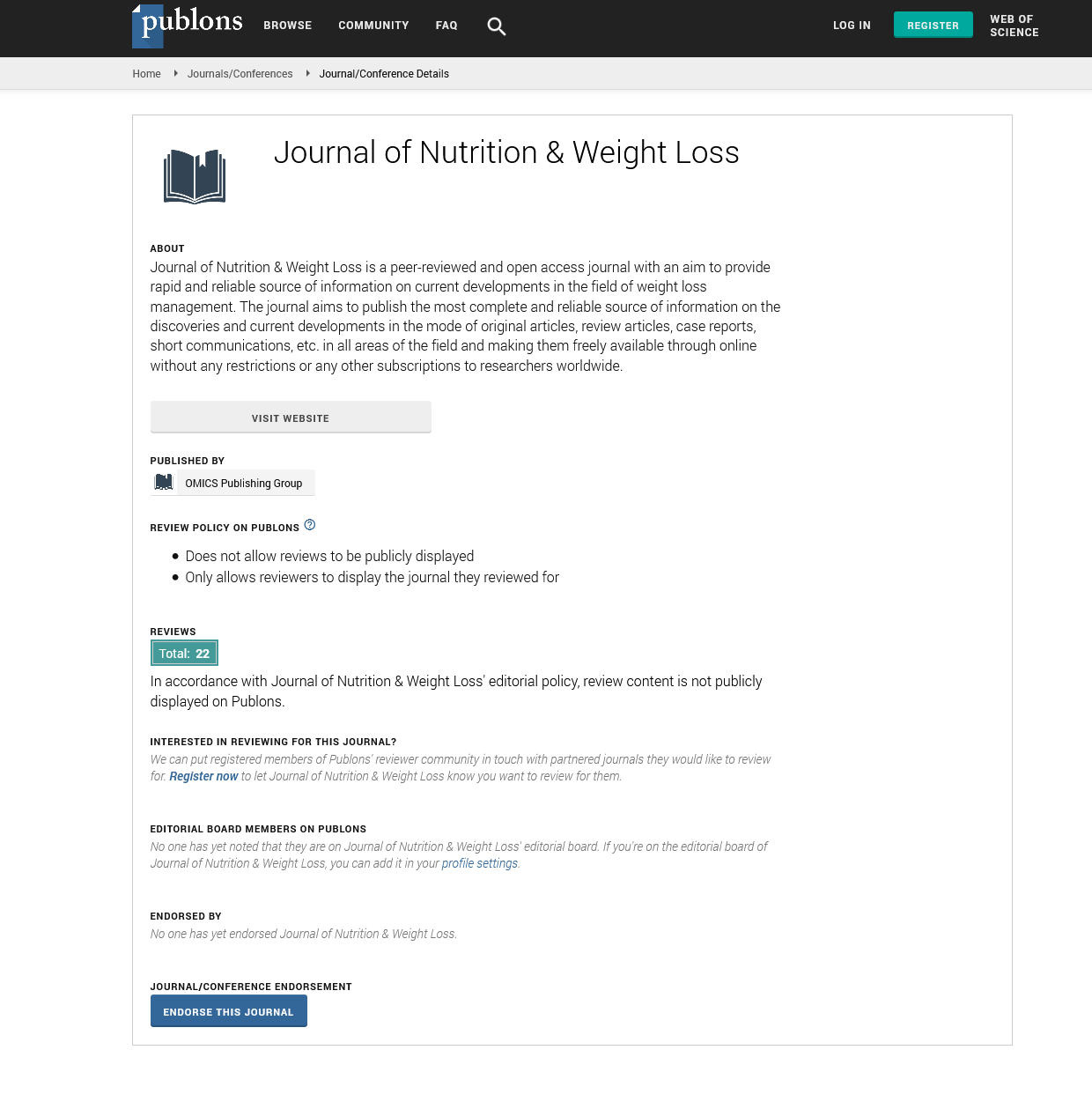Indexed In
- RefSeek
- Hamdard University
- EBSCO A-Z
- Publons
- Euro Pub
- Google Scholar
Useful Links
Share This Page
Journal Flyer

Open Access Journals
- Agri and Aquaculture
- Biochemistry
- Bioinformatics & Systems Biology
- Business & Management
- Chemistry
- Clinical Sciences
- Engineering
- Food & Nutrition
- General Science
- Genetics & Molecular Biology
- Immunology & Microbiology
- Medical Sciences
- Neuroscience & Psychology
- Nursing & Health Care
- Pharmaceutical Sciences
Commentary - (2021) Volume 0, Issue 0
Relationship between Nexus Diet on Lipid Metabolism and Tumor Microenvironment
Sonika Sharma*Received: 09-Nov-2021 Published: 30-Nov-2021, DOI: 10.35248/2593-9793.21.s4.143
Commentary
Obesity is a main contributing variable to disease advancement around the world. Epidemiological proof recommends that diet influences malignant growth hazard and furthermore considerably changes restorative result. In this way, concentrating on the effect of diet in the turn of events and therapy of malignant growth ought to be a clinical need. In this Review, we set out the proof supporting the job of lipid digestion in molding the growth microenvironment (TME) and disease cell aggregate. We will talk about what dietary lipids can mean for aggregate in this manner influencing illness direction and treatment reaction. At last, we will place expected procedures on how this information can be taken advantage of to expand treatment viability and patient endurance.
Overabundance caloric admission prompts corpulence and is a significant danger factor for diabetes, cardiovascular sickness, stroke, and frequency of disease around the world. Without a doubt, high muscle to fat ratio is related with an improved probability of fostering various hematological malignancies, and bosom, oesophageal, renal, colon, pancreatic, and endometrial diseases. Forthcoming examination of 900 000 disease free grown- ups in the US showed that people with the most noteworthy weight record (BMI) had a 52% and 62% expanded danger, separately, of kicking the bucket from malignant growth than their typical weight partners. Expanded body weight and fat tissue brings about modified chemical levels, like expanded oestrogen and insulin, which assume significant parts in disease advancement and can bring about foundational metabolic changes; that is, hyperglycemia or raised degrees of coursing lipids. Weight likewise advances tissue aggravation and vascular brokenness.
Notwithstanding, there is restricted comprehension of the immediate effect that diet has on cells inside the TME. For instance, it isn't notable whenever raised blood glucose levels advance the multiplication of disease cells or then again whenever expanded lipid accessibility in the TME elevates malignant growth cells to utilize these lipids as an energy source or substrates for film combination. Epidemiological proof recommends that diet generously changes therapy result in malignant growth patients; that is, meta-investigations show that bosom disease repeat is 30% higher in stout ladies contrasted with their ordinary weight partners. Accordingly, a superior comprehension of the impact of diet, specifically the starch and fat-rich western eating routine, on supplement accessibility inside the TME and its effect on flagging pathways that decide drug affectability is fundamental for the improvement of novel anticancer treatments. In this Review, we examine lipid digestion inside the setting of the TME and investigate what diet can mean for malignant growth aggregate, infection direction, and treatment reaction.
The amalgamation of lipids is a profoundly organized and controlled atomic program managed by the sterol administrative component restricting proteins (SREBPs), which react to upstream flagging organizations (i.e., PI3K/AKT/mTORC1 pathway) and to the cell supplement status (i.e., climate exhaust of lipids) to direct the statement of catalysts engaged with cholesterol and unsaturated fat (FA) combination and take-up. Lipids are a profoundly different class of organic particles, including FAs, fatty oils, sterols, just as phospholipids and glycolipids – the vitally primary parts of natural layers. Unusual lipid digestion is found in numerous human diseases, transcendently yet not only to keep up with sufficient creation of phospholipids to produce the layers of malignant growth cells. Again blended lipids are likewise utilized by disease cells to create energy through unsaturated fat oxidation (FAO) and are needed for post-translational adjustment of proteins.
Changed lipid digestion is additionally connected with oncogenic occasions in malignant growth. In lymphoma, enhancement of MYC prompts upregulation of all over again lipogenesis, recommending it is needed for MYC-subordinate change and development. MYC helps out SREBPs to manage lipid amalgamation and cancer development in various disease types. Clear cell renal cell carcinomas (ccRCCs), portrayed by useful loss of the von Hippel–Lindau (VHL) cancer silencer that prompts adjustment of the hypoxia inducible elements (HIFs), show a change in cell digestion where glutamine-determined carbon is solely utilized for anew lipogenesis. For sure, ccRCCs are histologically characterized by the presence of enormous organelles that store glycogen and lipids, subsequently modified lipid digestion is key to the growth aggregate.
Disease changes unite on liberated digestion and oncogenic area of interest transformations are additionally found in metabolic proteins. For example, transformations in IDH happen in poor quality gliomas, auxiliary glioblastomas, and intense myelogenous leukemias (AML). Point transformations in IDH1 lead to neomorphic movement and creation of the oncometabolite 2-hydroxyglutarate (2-HG). Amassing of 2-HG adjusts the movement of oxoglutarate-subordinate dioxygenases; a few of which control the methylation province of DNA and histones. Wild-type isocitrate dehydrogenase (IDH) proteins in disease can likewise reductively carboxylate a-ketoglutarate to create citrate, permitting glutaminederived carbon molecules to be moved into lipid blend, especially when the action of the carboxyl corrosive (TCA) cycle is weakened, for example, under hypoxic conditions or in cells with faulty mitochondria. IDH1 protein articulation is additionally upregulated in essential glioblastomas, with its hindrance bringing about diminished levels of a-ketoglutarate, decreased NADPH creation, and lower transition of acetic acid derivation and glucose- inferred carbon into lipids. These metabolic changes are joined by modified histone methylation and differential articulation of separation markers, proposing that adjustments in metabolic qualities sway metabolic pathways as well as influence worldwide quality articulation through epigenetic systems.
Explicit parts of the lipogenic hardware have been displayed to play a protumorigenic job in a few tumors. For instance, unsaturated fat synthase (FASN), a critical downstream objective of SREBP answerable for the NADPH-subordinate amalgamation of palmitate, is upregulated in bosom, prostate, ovarian, stomach, and colorectal malignant growths. Expanded FASN articulation corresponds with set up oncogenic occasions, for example, HER2 intensification in bosom disease and PTEN misfortune in prostate and ovarian tumors. Endeavors to effectively hinder FASN for malignant growth treatment have been hampered by startling harmfulness and metabolic remuneration by means of lipid take- up. Consequently, lipid digestion is key for growth movement and focusing on it very well may be adequate in disease, however understanding the conditions and setting that gives affectability to restraint is critical to the advancement of fruitful treatment techniques.
The turn of events and clinical testing of novel anticancer specialists that show promising preclinical viability is a difficult cycle, where starting patient advantage saw in little preliminaries is frequently not reproducible in bigger preliminaries. This absence of reproducibility could be clarified partially by the contrasts between preclinical models in the research center and cancers in patients. Seeing how the hereditary design of growths helps out the phone and metabolic structure of the TME to decide aggregate is significant to finding these original weaknesses. Specifically, fruitful remedial procedures need to consider the complicated connections between various cell populaces inside the TME that are dependent upon dynamic changes in supplement supply, especially because of treatment.
Besides, we want to apply the full collection of the clinical tool compartment, for example, strong hereditary, histological, or biometric imaging biomarkers, permitting patient definition and fleeting observing of treatment reaction. To be sure, the absence of suitable biomarkers for designated treatments that could be more solid in patients with a higher BMI or in patients that follow explicit dietary regimens is among the greatest difficulties we face in deciphering preclinical discoveries on metabolic weaknesses into clinical impact. Accepting this ecological heterogeneity with logical thoroughness is the main course to clinical advancement and a definitive objective of further developing disease treatment and patient result.
Citation: Sonika S (2021) Relationship between Nexus Diet on Lipid Metabolism and Tumor Microenvironment. J Nutr Weight Loss. 6:143.
Copyright: © 2021 Sonika S, This is an open-access article distributed under the terms of the Creative Commons Attribution License, which permits unrestricted use, distribution, and reproduction in any medium, provided the original author and source are credited.


